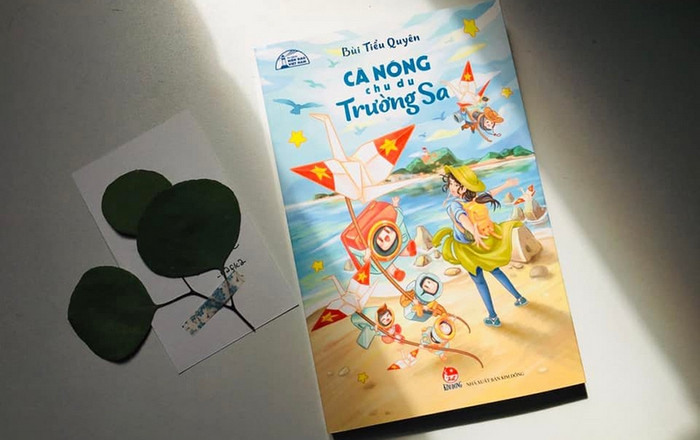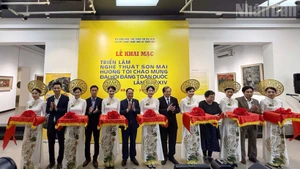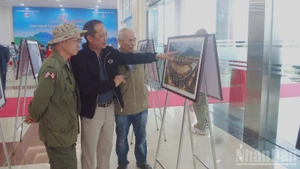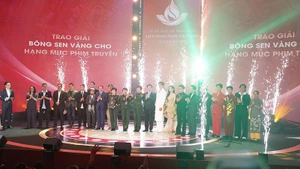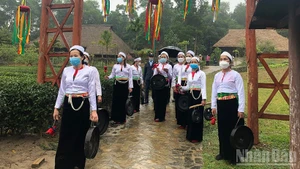Nhan Dan (People) Newspaper reporter interviewed writer Bui Tieu Quyen about her work.
Aspirations to contribute one more story about Truong Sa (Spratly)
Q: When I read your work, I was really surprised. There have been so many articles and literary works about sea and islands, especially Truong Sa, that many people thought that it was difficult to discover and exploit new things. However, with your own work, you proved that creativity has no limits. Could you share about your ideation and conception of “Ca Nong travel to Truong Sa” as well as your choice of a “camera” named Ca Nong as the main character?
A: After receiving the decision of going on a business trip to Truong Sa, I immediately bought books about the archipelago, including both literary books and documentaries. It is true that there are several great books and articles on Truong Sa, but I still felt it is not enough. As a very natural thought, I want to make small contributions to that missing part, with a story about Truong Sa after the trip.
In fact, during nine days at sea, until I returned home, I still did not know how I should write. I thought a little bit every day and six months later, I could write.
I chose a camera as the main character because during my voyage to Truong Sa, the camera, an inseparable and most precious objective, that kept all the images I wanted to capture, seeing everything I wanted to see and hearing everything I have heard. When I humanised the camera, I realised it was my companion during my trip. It was always silent but understanding all.
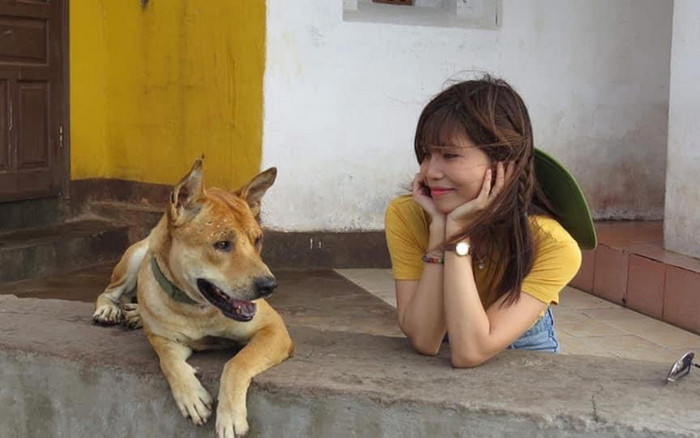
Writer Bui Tieu Quyen on Da Thi island
Q: This is your first feature story written for children. What was the biggest challenge you faced while writing this piece?
A: The most difficult stage was the ideation and methods of expression. Perhaps not only for “Ca Nong travels to Truong Sa”, but also for all other works in any genre, I thought carefully before writing, as well as arranged emotions and stories and distilled the details in my head.
Sometimes, I thought about my upcoming work so much that I memorised the stories, as if I had read them. I didn’t know what to call it either, but it helped me both in my daily work and in writing.
‘Ca Nong travels to Truong Sa’ is my first longer story for children. However, unlike my first work, this is a story that I wrote when I found myself having crossed another threshold of age, thought and literature. I know writing for children is a challenge for me. However, during the time I wrote “Ca Nong travels to Truong Sa’, I saw that playing with children through books was so cute and sweet.
Q: Did your experience as a journalist help you in making this special book?
A: I think journalists always have good observations, integrated thinking, acumen and the ability to grasp events and phenomena. Especially, we always pay attention to taking notes and save necessary documents and images. The time for the delegation’s members to visit each island and rig was not much, because we have to hurry back to the boat to avoid the tide. I knew I only had a short time to see, to learn, record information and remember as much as possible in Truong Sa and the southern continental shelf. I felt and knew what details are needed for press and literature. My mind automatically ‘categorised’ and I recorded them as a log-book. As a result, when I started working on the manuscript, I had my source of ‘memory material’.
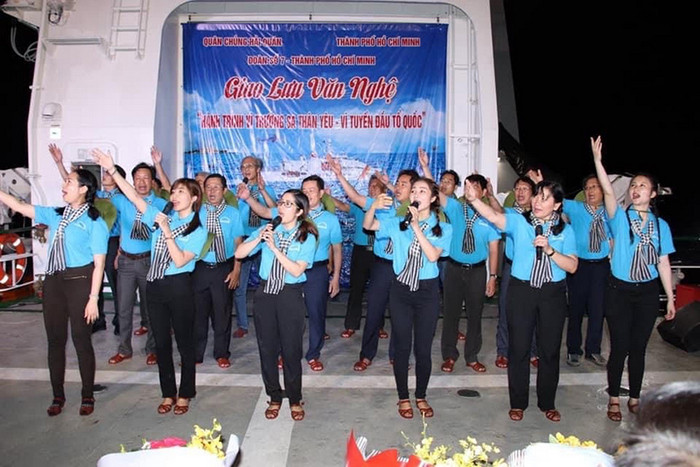
Writer Bui Tieu Quyen (second from left in the front row) in an art performance on KN290 ship during her business trip to Truong Sa
Peace of mind when writing
Q: I was very impressive with your sharing, that in addition to answering the questions of witting for whom and how to write, writers should pay attention to the question “Is your heart really at peace while sitting with the manuscripts?”. Why is the word "peace" so important to you?
A: The peace while writing is a very quiet and pure feeling, which allowed me to live more deeply with literature, project my eyes into a larger dimension and think about bigger things. The peace of mind in writing is my choice when I feel that I have passed a young age with lots of nostalgia and I also wrote what the youth wished to write. The literary career of a writer is inherently a process of discovery, experience, maturity, identification and self-improvement.
The peace of mind in writing for children is even more necessary for me. Otherwise, I am afraid that the "chaos" inside my mind will affect my writing. We do not let the negative emotions of adults interfere with the pure world of children. I did not write ‘Ca Nong travels to Truong Sa’ when I felt tired or sad. I learnt to keep a quiet place in my soul to balance and purify, in order to see clearly that what I wished to do would give me an invisible fulcrum and a great spiritual strength for the next steps. As a result, I have sown such a land where the trees of ideas, wishes, love and faith for people, life, earth and sky keep sprouting.
Q: ‘Ca Nong travels to Truong Sa’ consecutively reaped many awards in 2021, including Children's Literature Prize of Ho Chi Minh City Writers’ Association and the 2021 Golden Apricot Blossom Awards for the category of the best cultural and art work. I believe there will be surprises for this book ahead. What are your thoughts right now aside from the joy of the book's success?
A: I am thinking about Truong Sa where ‘Ca Nong travels to Truong Sa’ has yet to return. At the end of June 2021, ‘Ca Nong travels to Truong Sa’ was released and I prepared the book as gifts to Nguyen Huu Phu, a teacher on Song Tu Tay island and the character who appeared at the end of the work. At that time, he was on a summer vacation in Khanh Hoa province. However, the area where I lived was blockaded and teacher Phu had to go to zone 4 for quarantine before returning to the island. Therefore, my gifts to soldiers, people and children in Song Tu Tay island are still here.
When I sent the books to the KN290 ship, which took me to Truong Sa, I knew that there was still no schedule for trips to the island. What I wish is that Ca Nong, Ni, So, Meica and uncle Te Le (characters in the work) can go to the islands and rigs soon. In my work, I wrote about Ca Nong’s confession that he was born in a factory, “no parents, no homeland”. I gave it a “homeland” which is the sea and sky. Ca Nong will go to Truong Sa in the form of a book, not traveling but going home.
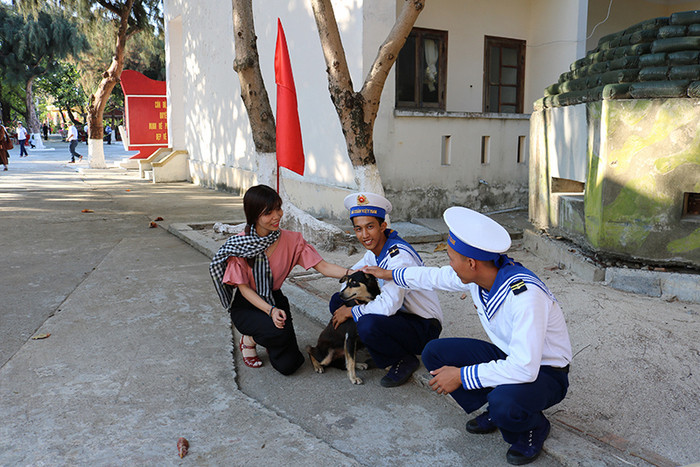
Writer Bui Tieu Quyen talks with soldiers on Son Ca island.
Q: The nine-day journey to Truong Sa has been impressively recorded by you through an emotional literary book. Do you still feel regret after the trip?
A: My biggest regret is that Ca Nong did not get to Nam Yet island, the only place in Truong Sa having coconuts. I have read many articles about Nam Yet, as well as the journey to bring coconuts from the mainland to the island for the soldiers to grow. Nam Yet is now full of coconut trees. There are many other interesting and meaningful stories highlighting the island's history. In the manuscript of ‘Ca Nong travels to Truong Sa’, I wrote a chapter about Nam Yet island, but I decided to give up. The journey and stories of Ca Nong and his friends are fictitious, but Truong Sa is real. Despite reading many documents, I did not dare to write about what I have not seen or felt in the remote island. However, as the character Meica said in my work, someone else will do what I have not completed.
Q: Readers, especially young people, have known Tieu Quyen through the pages full of thoughts and experiences about life. Your change in a new topic showed that your "reservoir" is still very abundant. Do you intend to invest more time and efforts in writing for children?
A: Somehow, I always have a clear schedule with literature as my long-term work schedule. I will not write as much as before, instead I will spend more time thinking about what I am passionate about, as well as read more books and learn more from my friends’ works. When I realise the right time for me, I will start my plan. I thought about a literature story for children before my trip to Truong Sa, but I gave priority to Ca Nong. The characters in that story are still waiting happily. Perhaps they understand that the right time is necessary.
| Writer Bui Tieu Quyen was born in 1985 in Long An province. She works for Ho Chi Minh City Women Newspaper and is a member of the City Writers’ Association. Quyen won the young writer award from Ho Chi Minh City Writers’ Association in 2014 with her work ‘Co doi phuong Dong’ (The Grass Hill of the East) and the Children Literature Prize by Ho Chi Minh Writers’ Association with the book ‘Ca Nong travels to Truong Sa’. |
